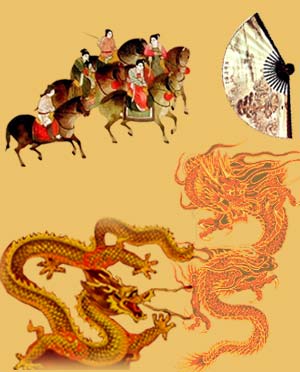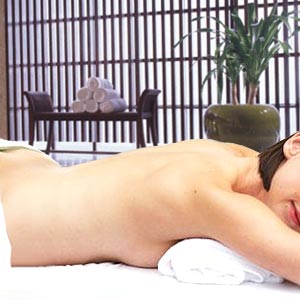Chinese Painting

Chinese paintings have been likened to visual poems - long graceful bamboo plants, birds and flowers of different sizes and shapes, bold bright dragons - capturing the wonders of nature on paper, silk or bamboo mats. Characterized by their unique brush strokes, Chinese paintings reflect minute details in a realistic style or involve freehand strokes that create rhythm and variety. You can find traditional Chinese paintings on wall murals, fans, scrolls and screens. Learn more about different brushes in Chinese paintings.
Chinese painting
Traditional Chinese painting received tremendous encouragement during the Tang Dynasty. The paintings of that period reflected the overall prosperity of that era. Painters used various styles to express their feelings and interest. While one school of painting used minute detailing to represent forms and figures (gongbi), the other uses fluid lines and strokes of brushwork to create rhythm and expression (xieyi). Decorative Chinese painting was done on carved jade and lacquer as well as pottery, silk and decorative bronzes.
Often Chinese paintings were done with black ink alone. This type of monochromatic work drew inspiration from calligraphy strokes. Animals such as horses, deer, fish as well as birds and people were represented with brush strokes in Chinese ink. In such Chinese paintings, the background was left blank to reinforce the main subject. The empty space was vital to the structural composition of the paintings.
Classical Chinese painting can be divided into three categories: landscapes, figures and birds-and-flowers. Landscapes done in ink and wash technique require considerable mastery over brush techniques. On the other hand, landscapes done painted with minute detailing and decorative style used bright blues, greens and reds. Whether it was the bright plum blossom or the stately pines and cypresses or the gushing rivers, Chinese paintings are unique in their structural composition. Other popular subjects for Chinese paintings are insects and fish and frogs.
Chinese painting technique
Chinese ink comes in solid form. The ink sticks are made from soot, pine tar, gelatin, herbs and spices. They are to be ground against an ink stone with few drops of water to produce liquid ink that can be used for paintings. The ink is very deep and glossy when applied thick whereas it can lend a translucent appearance if applied with plenty of water. With just black ink alone, a painter can play with contrasting light and brightness. This is referred to as the 'five colors of ink' - black, white, wet, dry and thin. You can depict the translucence of a shrimp shell or the rough calluses on a bamboo shoot.
The kind of brush used along with the degree of moisture on the brush can produce a range of expressions of texture and space. A typical Chinese painting brush is crafted from bamboo and the soft hair of a rabbit, sheep or weasel. Chinese paintings are done on xuan paper or silk. You can pick up an exquisite Chinese painting scroll or mural.
Chinese paintings are done on folding fans and round fans too. Made of paper or silk, these fans are fine and elegant. When painting on silk, it is treated with alum and glue to make it less absorbent. But brushstrokes appear best on paper. Chinese rice paper can be either rough or smooth. Processed paper is treated with soybean milk or liquid glue to make it less absorbent.
Brush Chinese painting
Chinese painting brushes are similar to watercolor brushes but come with a finer tip. The softer brushes are made of sheep hair while the deer or fox sable brushes are more resilient. Very soft brushes are made of fleece and are highly absorbent. Such brushes are ideal for painting flowers and leaves with lots of moisture. On the other hand, stiff brushes made of weasel hair are used for drawing bold lines such as bamboo or orchids. Different types of Chinese painting brushes:
- Hsieh chao pi: Crab claw brush, large and small sizes
- Hua jan pi: brush for painting flowers
- Lan yu chu pi: brush for painting orchids and bamboo
If you are learning Chinese painting, you would need to stock up each of the types. Store them well and clean them and squeeze dry after use. Learning and practicing various brush strokes is vital to Chinese painting. How you hold the brush, how you move it and how you lift it creates different effects. Chinese painting is not about mechanical strokes - you will fail to lend vibrancy and life into the subjects. Instead you need to coordinate your wrist, hand and elbow to create thin, thick, square, long, hard and soft strokes. There are various brush strokes in Chinese painting such as raindrop, ax-cut, zigzag and ox hair style.
Top of the Page: Chinese Painting
Tags:#chinese painting #brush chinese painting
 Recreation Ideas
Recreation Ideas Needle Crafts
Hobbies - Recreation
Chinese Painting
Travel Accessory
Travel Packing Tip
Basic Survival Skills
Outdoor Survival Skills
Survival Kits
Travel Recreation
Scuba Diving Vacation
Stained Glass Art
Candle Making Tip
Staycation Ideas
Top of the Page: Chinese Painting
Popularity Index: 101,009

